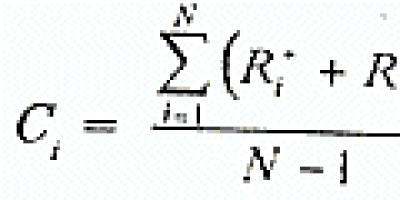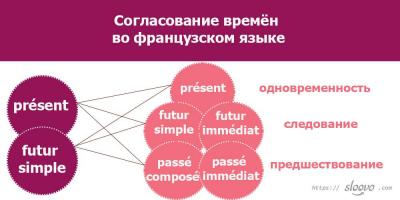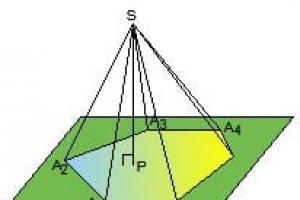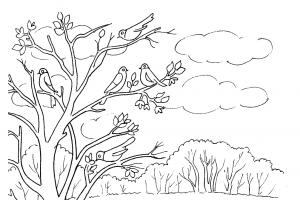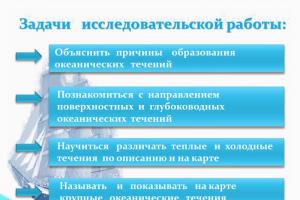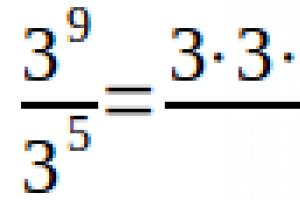3. Stage II. Practical implementation of the project.
4. Speech development in Russian language development lessons.
5. Psychodiagnostics in Russian language lessons.
6. "About the love of spelling rules..."
7. Development of spelling intuition in Russian language lessons.
8. Associative algorithm for memorizing dictionary words.
Associative algorithm for memorizing dictionary words
For a child from his first steps in educational activities in the Russian language textbook by O.L. Soboleva offers three alternative paths, three ways to master literate writing: meaningful application of the rule, appeal to spelling intuition and memorization.
Memorizing the spelling image of a word on a conscious level is one of the effective ways to master literacy. The author simultaneously solves two problems: to help the child remember how specific words are written, and much more important - to promote the intensive development of brain structures, and not just memory.
In the textbooks of O.L. Soboleva has virtually no mechanical memorization. It is no secret that in large doses it can lead to dulling of abilities and a decrease in the creative potential of the child. In addition, such memorization does not at all contribute to increasing interest in the subject. Therefore, it becomes natural and necessary to turn to the child’s vivid emotional-figurative memory, to the enormous possibilities inherent in the associative way of thinking.
A godsend in this regard was the associative method of memorizing and assimilating information developed by Vasily Agafonov, the author of the original textbooks “Wrong Rules”, “Completely Wrong Rules”, “Count in Rhyme” and many others. His wonderful fairy tales and poems, in which an associative memorization algorithm is implemented, became the basis for dictionary work when creating the textbook.
The memorization algorithm that the author offers the child in textbooks is extended primarily to words with unchecked spellings, that is, to dictionary words. However, any word whose spelling follows a rule, of course, can also be remembered. Thus, in relation to any word, children can choose between the rule, spelling intuition and their own memory. Among other things, this works to develop the child’s alternative thinking and develops his ability for introspection: he learns to understand himself and listen to himself. It is very important.
The essence of the algorithm is to find a clue, an associative thread, a bridge between the word you want to remember and another word in which the “stubborn” letter is heard clearly and clearly.
At the first stage, the associative “hook” is included in the emotional and figurative context of the fairy tale or poem. In addition to the text, in which the image of the letter necessary for memorization is repeated in various ways, there are also drawings. There are many additional threads in the drawings, secondary “clues” that enhance the memorization effect. A visual metaphor excites the child’s emotional memory, activates his attention to the object of memorization, and ensures the selective focus of this attention. The organic combination of verbal and graphic images creates a solid foundation for non-violent, active and long-term memorization. Here's how it could be:
TALE OF A TANK WITH "O"
Once upon a time there lived a baka. She knew how to bark, wag her tail, guard the house and loved to howl at the round moon, which looks a little like the letter "ABOUT". And bite a bagel that looks like a letter "ABOUT". She also loved to look at the round cloud and the round sun, which looked like the letter "ABOUT", loved autumn, which begins with the letter “O”. In general, of course, you guessed that she fell in love with the letter itself "ABOUT". And when I fell in love, I wanted to be written with this letter.
“Okay,” they told her, “we’ll write you.” "sides".
No, I don't want that! From what other side?! - Baka was offended. - I don’t want to be called that! I just want to pee with "ABOUT".
And they began to write it with "ABOUT".Like this: with "ABOUT» tank. And then simply: dog. That's how they still write.
(V. Agafonov)
As you can see, there are many threads, and they permeate the entire text of the fairy tale: these are words where “O” is stressed, and words that begin with this letter, and playing with its shape - focusing on real objects that resemble this letter in shape: round moon, donut-shaped letter "ABOUT", round cloud, round sun.
There is also a subtext, working with which, according to neurophysiologists, activates thought processes and is a powerful factor in the development of a child’s brain structures.
And finally, there is a drawing. You will be able to see on it the written image of the letter “O”, and an abundance of round objects that the child eagerly and very quickly finds: a window in the house, a plate, etc. The color, the major energy of the drawing, its features, which take into account the holistic and at the same time discrete perception of the child, help to remember.
In each case, the magic strings, as we call them with children, are different. So, in order to remember how to spell birch, it was enough to just read four lines with the children once:
The birch was so white
What is the letter "E" from the word "white"
Came to her unnoticed
And I didn’t want to leave.
(V. Agafonov)

As soon as a child “enters” the picture, gets used to it (and this happens in a few seconds) and looks closely at the expression on the face of the birch tree and especially the letter itself, so reverently and tenderly clinging to the trunk - and it is simply impossible to write a birch with a letter "AND".
By the way, I asked the children what line the artist drew, and I always heard the answer: the fourth, “and didn’t want to leave”. After whatever time this word appears in the dictation, the image perceived from the drawing and text will instantly and involuntarily appear in the child’s mind - and there will be no mistake.
However, poems and fairy tales, a spacious context for an associative “hook” at the next stage of mastering the algorithm are no longer necessary. A simple image is enough. For example, to remember the word cucumber, you can imagine a huge, huge cucumber and say to yourself: “Wow! Wow, what a cucumber! Huge, good! And he himself looks like the letter “O”. It starts with the letter “O”!” That's all!
It turned out that a child is much easier than an adult to invent his own strings and attach words to them, “like balloons.” I find that the very word “stubborn” helps my students. “They lacked this word, just as they lacked the verb invent instead of compose. They just want to redirect the “stubborn” words and write them correctly, without mistakes.” Perhaps, in fact, the semantics of the word stubborn evokes certain emotional impulses, the motivation to memorize, the motivation to search for specific techniques that can help “re-stubborn” the word are enhanced.
Later, the author only offers his own version of the associative “hook”, letting the child understand that this is exactly an option. You can do it, for example, like this. We place three vocabulary words in a scarlet frame: wheel, page and scarf. A metaphor is introduced into the task: “Try to tie each stubborn word to another word...”. And just below:
Does the wheel have spokes?
Is the page strange?
Did they make a dress for Thumbelina from a scarf?
Look for the magic threads!

In fact, this is how you imagine a bicycle wheel, from which sharp spokes stick out and are prickly. They are To ABOUT are flying, That's why To ABOUT forest!
Interesting fact! Children do not confuse helper words that they find by association and related words. In their minds this is clearly separated, and no special effort is required for this: only once, once and for all, separate these concepts. With question marks, we seem to be telling the child: “This is what we came up with, but maybe you have another option? Another image? You can use ours, or you can use yours.”
And it is very important that a child already at the age of seven understands that everyone has their own associations, although they can sometimes coincide in different people. It is very important to teach a child to involuntarily find the image that suits him best and makes it easier for him to remember, and to trust himself in this regard.
The very image of magic strings (both verbal and in drawing) also works. Threads, knots, bindings, hooks, bridges - all these words, when a child hears or reads them, stimulate associative thinking and contribute to the involuntary emergence of images and associative chains.
The skill of associative work is formed in younger schoolchildren so quickly that by the end of the first grade they are far ahead of their parents, and often their teachers. And most importantly, they like to remember this way.
Cutlet
Once upon a time there was a cat. He didn't like winter, but he loved summer!
I loved it so much that I started traveling around the world to catch up with summer. The cat became famous, and they began to call him Cutlet.
Summer Cat was an excellent cook. He invented various meat dishes. One day he took minced meat, added onions, eggs, salt, pepper, mixed and formed small round cakes. Summer Cat fried them in a frying pan. Everyone liked the new dish. People went to the cat Kot-leta for a recipe. He opened a restaurant where the specialty was minced meat cakes. Everyone loved this dish and named this flatbread in honor of the cat Kot-leta - CUTLET. Since then, everyone knows cutlets!
Frost
Once upon a time there were two letters - "AND" And "Y". They were very similar to each other, although slightly different. U "Y" there was a bow, and "AND" He was absent. The first graders confused them all the time. Instead of "AND" wrote "Y" or vice versa.
One night the letters conferred and came up with a way to help the children. They asked for a syllable "Not" settle between them. and a proposal appeared on the board “I – not Y!”
In the morning the children saw him and were happy. The letters helped them a lot. And the teacher said: “What a beautiful word is silver on our board!"And the children read the word in chorus "FROST". From that day on, they forever remembered how to spell this beautiful word.
And one girl drew a whole visual aid that helps you remember how to spell the word precipitation. She drew a huge cloud on a large piece of paper and wrote CLOUD next to it. Then I drew rain and snow coming from this cloud and wrote: PRECIPITATION. And she connected these two words with an arrow: precipitation - because from the cloud. Great!
But the point is not to remember thirty, or forty, or even two hundred specific words, and not even to learn to remember the spelling of any word in this way. The most important thing is that the children extrapolate the associative memorization algorithm to any educational information in general - in mathematics, natural history, in any subjects. However, this is probably not even the most important thing, but the fact that this algorithm develops, that it imparts the necessary impulse to associative processes in brain activity, and increases the creative potential of children. Well, it’s simple - it makes life in the classroom more interesting and emotional. The associative technique is not the only one with which the author helps children remember the image of a word. There are many other techniques: playing with type, saturating the text with a certain letter and sound, etymological discoveries that we make. However, the associative line remains the leading one. It even passes through etymological analysis. An active need for a metaphor that carries information is formed in the child; not only the skill of assimilating such a metaphor is developed, but also the skill of creating it.
When working with a metaphor (both someone else’s and your own), emotional memory is activated, memorization and assimilation become fast and strong. It must be said that the associative technique, and in particular those of its techniques that work on memorization, help to coordinate different channels of perception: visual, auditory and kinesthetic, and this is one of its advantages. Let there be another poem in this article about the “stubborn” word. My children and I continue to learn to remember!
Little painter

Once I painted a ball
A very small painter.
The painter was small in stature,
He fell from the stepladder.
Fell down from the stepladder
I hit the letter "A" with my hand.
The hand got stuck in the letter "A"
And grief is not enough for him:
“So what if I fell?
So what if he’s short?
But I painted the ball,
Because I'm a painter!"
(V. Agafonov)
Positive effects:
Children write vocabulary words almost without errors. And the algorithm for memorizing vocabulary words has become the children’s favorite “equipment” for training their imagination and memory. They often offer their associations, ideas, images, come up with fairy tales and even write poetry.
Increasingly, primary school teachers are using mnemonic techniques when working with vocabulary words.
Mnemonics (from the Greek mnзмз - memory and tйchnз - art, skill) - the art of memorization, a set of techniques and methods that facilitate memorization and increase memory capacity through the formation of artificial associations, it is a system of internal writing that allows you to consistently record information transformed into the brain in a combination of visual images. Mnemonics uses the natural memory mechanisms of the brain and allows you to fully control the process of memorizing, storing and recalling information.
As we mentioned above, the thinking of primary school students is visual and figurative in nature, i.e. it is based on specific ideas and images. In this regard, the majority of them have a correspondingly predominant figurative type of memory.
Successful memorization is facilitated by compliance with certain conditions:
1. Memorization mindset: the student must want to remember what he needs to remember.
2. Interest: it is easier to remember what is interesting.
3. Vividness of perception: everything that is bright, unusual, and that which evokes certain emotions is better remembered.
4. Imagery of imprinting: memorization based on images is much better than mechanical memorization.
The essence of using mnemonics when memorizing vocabulary words is to use an associogram picture, a hint word or a mini-fairy tale to come up with an image so that a word that is difficult to spell is easily remembered, and the children are sure which letter should be written in it. There are many ways to “brighten” a spelling and attract special attention to it. “Strengthening” occurs due to the figurative presentation of the material, by building a memorization storyline, composing original stories, fairy tales, poems, fables, jokes.
Effective techniques for “strengthening” spelling are:
1) writing a memorized letter in a word by analogy with the object itself;
2) compiling puzzles;
3) use of rhymes;
4) learning in a generalized way by composing stories;
5) appeal to the history of the word - etymology.
Below we will consider several methods, which include the above methods of figurative memorization of words.
Etymology is a branch of linguistics that studies the origin of words, as well as the very origin of a word.
Elements of etymological analysis are introduced into work with Russian words that are simple in structure. Frequently used and accessible to students by origin (birch - goes back to the word white, big - to the primordial pain - “strength”, cow - to the common Slavic kor - “horn”, head of cabbage - to the word hummock, frog - to the primordial lyaga from kick - “to kick”, cucumber from cucumber - “unripe”, pie - to the original feast). At this stage, children do not need to be told the source language; the word “in the old days” is enough.
Etymological analysis - elucidation of the previously existing morphological structure of a word, its past word-formation connections, determination of the time and source of the appearance of the word, establishment of the method of its formation from the corresponding generating stem
Etymological analysis is an effective technique for enriching the vocabulary of primary schoolchildren. This technique can serve as an important means of explaining the meanings of incomprehensible words related to natural history, moral and aesthetic concepts in Russian language and reading lessons.
Based on the fact that spelling skill is formed in the process of speech activity and has a substantive and operational side, we can distinguish four stages that contribute to a qualitative change in the skill of spelling unverifiable and difficult to verify words.
1. Preparatory stage.
The goal of this stage is to equip students with the necessary theoretical knowledge and practical skills that make up the content side of the skill of spelling vocabulary words.
2. Indicative stage.
The object is an unverifiable word, and the goal is the correctness and awareness of its spelling.
3. Consolidating stage.
A variety of creative tasks are used that develop the mind, activate the imagination and fantasy of children.
4. Stage of control and self-control.
At this stage, dictations, presentations and games of entertaining grammar should be carried out.
According to A.N. Tikhonova, knowledge of the etymology of a word, the rules of word formation, the ability to divide a word into its component components, determine the role and meaning of parts of a word helps to avoid many mistakes, helps to improve literacy and speech culture.
So, the use of etymological analysis in Russian language lessons when working with words with unverifiable spellings puts teaching spelling on a scientific basis. In this case, the child’s consciousness is involved, due to which vocabulary and spelling work becomes more effective. When using etymological analysis in lessons, it is necessary to clearly distinguish it from morphemic analysis in order to avoid incorrect morphemic division of words. Etymological analysis in elementary school should be used as an auxiliary technique for spelling, lexical and other practical purposes and carried out by the teacher, taking into account the age characteristics of students. In this case, etymological certificates are available to younger schoolchildren and are perceived with great interest. At the same time, the explained words are acquired by schoolchildren both in meaning and in terms of spelling.
Unfortunately, etymological analysis is rarely used in elementary school for spelling purposes. The reason is that schools are insufficiently equipped with material specifically focused on such analysis. Therefore, the types of work presented below will help students consolidate their acquired knowledge, skills and abilities in the process of vocabulary work based on etymology.
1. Stories about the origin of words.
2. Etymological dictionaries “To the origins of the word”, compiled by students based on materials from the words they have studied.
3. The game “Is it true?”, developed by O.N. Levushkina.
4. Etymological crosswords.
5. Dictation with justification.
For example, (soldo) soldier, (tetra) notebook, (kara) pencil, (slave) work, (cucumber) cucumber.
6. Self-dictation.
For example: remember and write down as many words as possible that contain a historical root - kol - (from kolo) with the meaning "circle".
(Wheel, stroller, ring, chain mail, about, outskirts, bun, etc.)
7. Auction of “difficult” words.
Done orally. The winner is the one who is the last to name a word with the characteristic specified in the task.
Name words that contain the consonant -oro-.
(City, peas, sparrow, frost, vegetable garden, road, crow, cow, good, etc.)
Based on knowledge of etymology, such work develops students’ attention, since children do not have to repeat words already named.
8. Miniature essay.
Students are asked to choose one from the proposed list of studied words and write a short essay on the topic: “Why is this word called that?”
9. Etymological exercises.
1) Tell me from what words the words hare, car, work are formed.
2) Determine what feature of the object its name indicates.
Birch, sparrow, cabbage, strawberries, shovel, pencil case, notebook.
The described types of work contribute to consolidating the knowledge acquired by schoolchildren about the etymology of words, the ability to divide words into morphemes both in modern and historical terms, the skill of comparing consonant words by meaning (and deducing the meaning of a word from its origin), knowledge about the spelling of dictionary words.
Scientists-psychologists - Matyugin Igor Yuryevich, Chakaberiya Elena Isakovna, Rybnikova Irina Konstantinovna and Slonenko Tatyana Borisovna, have developed an original scientific methodology that uses simple and effective methods of memorizing vocabulary words:
1. Method of graphic associations.
2. Method of sound (phonetic) associations.
3. Combined method.
4. Generalization method.
This technique has been tested for many years in the “school of Eidetics.”
Eidos is “image” in Greek, and eidetism is a type of figurative memory, expressed in the preservation of bright, visual images of objects for a long time.
Eidetics is the doctrine of subjective visual images observed in children and adolescents in a certain phase of their development, and also sometimes preserved, mostly as an exception, in adults.
Eidetics includes a system of gaming exercises that are aimed at developing memory, attention, and imagination. Games and exercises use the inherent ability of every child to imagine. While externally entertaining, the exercises are based on modern scientific ideas about the structure of attention and memory. Eidetics techniques can be used directly in the classroom. This is why there are games: “What does a letter look like”, “Transformations of words”, “How words are formed”, “Complete the letter”, “Change one letter - the word will change”. Riddles, crosswords, charades, and puzzles teach children to think figuratively, compare, find differences, and transform one object into another. Thus, they become acquainted with the simplest techniques of eidetics and mnemonics, and most importantly, learn to think creatively, that is, outside the box, outside the box.
Graphic association method Children like it more than others. Its essence is that the child, in order to remember the word, makes drawings on letters that cause difficulty in writing. The memorized letter can be large or small, printed or written, in any font.
R A KETA ( A- rocket),
YAG ABOUT YES ( ABOUT- berry).
FOREST T NICE ( T- ladder)
Z A VOD ( A- plant pipe)
Behind I ts ( I- bunny)
G O roh ( O- pea)
Vocabulary words with pictures for quick memorization are presented in a very diverse manner in the book by O. D. Ushakova. “Write the dictation without mistakes!” .
Sound method(phonetic) associations.
The method of sound associations was used in the compilation of quatrains by the author of the book “Dictionary in Verses” E.Z. Soldatova.
Difficult words to learn
The game helps us.
Pe Tuha was called “ Pe cha”-
Pe He loves it at dawn.
A honey because, on the contrary.
Doesn't like to sing, loves honey.
So as not to be offended O rowa
And it didn’t turn sour O l O co,
We are both of these friendly words,
Let's write at the root with the letter ABOUT.
Look, children,
Cancer flies to cancer yeah.
Once Nata is in the room A she came in
And the letter A she found.
There's a letter there A was captured
Between the letter T and the letter N.
You can also use humorous questions and riddles.
In what words spruce"growing"? (teaches spruce, potato)
The following technique is used when there is a successful consonance between the phrase and the dictionary word.
For example, the word breakfast. The word that is consonant with it is cancer. If you combine these two words in one phrase, you get:
For tomorrow cancer - cancer.
You can also use the following phrases:
Kos you in braid Tyume, and Pa led to pa lto.
By memorizing such phrases, students practically do not make mistakes in these vocabulary words.
The disadvantage of this method is the accumulation of phrases when selecting consonances for words with two or more untestable letters. In which case is it recommended to use a combined method.
Combined method- this is the use of both graphic and phonetic associations simultaneously when memorizing a vocabulary word if this word contains several unverifiable letters.
Etc And vetl And V O(2 And- outstretched palms for greeting).
Hello in in Ron in roars.
Generalization method.
When using this method, students are asked to:
1. Imagine objects, phenomena or actions that words mean.
2. Combine words into groups.
3. “Revive” groups of words by composing sentences.
Cla ss
Su bb ota
RU ss cue
At our classroom ss and in su bb where was ru ss cue language.
Apartment
pencil
Katya's apartment A mercury to A artina, on to A mouth to A rand A shom drawn art A can.
WITH O tank
With O rock
apple O To O
Shameless with O baka stole from O rocky apple O To O.
Psychologists say that information supported by emotions is recorded in memory better. And the more students use experience, supported by vivid memories, when coming up with the plot of pictures, the better the result will be.
We have proposed another method of memorizing vocabulary words - method of using fingerprint gestures.
Dactyls are gestures that represent the letters of a verbal language.
The Russian dactylic alphabet is an auxiliary system of Russian sign language, in which each gesture of one hand corresponds to a letter of the Russian language. There are 33 letters in the Russian language - accordingly, there are the same number of dactyls. Pronunciation is carried out according to the rules of Russian spelling.
To enhance memorization and emphasize the “difficult place” in a vocabulary word, we propose to show a gesture indicating a letter that corresponds to an unchecked spelling.
Analyzing non-traditional methods and techniques for studying vocabulary words, we came to the conclusion that the use of figurative memorization, etymological analysis, and the use of the sign alphabet will arouse a keen interest in the learning process among students, diversify Russian language lessons, fill extracurricular activities with creativity, and also serve as a way to develop all mental processes of students in general.
Conclusions on chapter 1
Based on the linguistic foundations of developing literate writing skills
among younger schoolchildren, as well as the age characteristics of children 9 - 10 years old and their consideration in the development of literate writing skills and analysis of traditional programs in 3rd grade, the following conclusions can be drawn:
1. Formation of competent writing skills is one of the most important and difficult tasks in a modern school.
2. When working on the development of spelling skills in students, it is necessary to rely on knowledge of the basic principles of spelling at school, as well as take into account the age and psychological characteristics of children.
3. The variety of rules of Russian spelling is explained, on the one hand, by the peculiarities of the phonetic and grammatical structure of the Russian language, the specifics of its development, and on the other hand, by interaction with other languages, both Slavic and non-Slavic. The result of the latter is a large number of words of non-Russian origin, the spelling of which has to be memorized.
4. Primary school age is a period favorable and receptive to any information coming from the outside; it is an important stage of learning, at which the foundations of language learning as a whole are laid.
Primary school students have great potential for the development of cognitive processes, which makes it possible to manage the learning process based on the psychophysiological characteristics of children of this age.
5. When conducting the educational process, for more productive learning by students, it is necessary to take into account the leading channel of perception of each student in the class and, based on this, if possible, present information in such a way that the children can see, hear and feel it.
6. The use of traditional and non-traditional methods of getting to know vocabulary words develops children’s attention, memory, thinking, and imagination. Non-traditional methods make the work of memorizing words with unverifiable spellings not only lively, exciting and easy, but also make it possible to expand both the vocabulary of students and the range of their literate writing, cultivating in them a love for words and language.
7. An analysis of traditional training programs for third-graders shows that insufficient time and space are allocated in the context of the lesson and in the annual plan for teaching spelling of words with untestable spellings. Therefore, in many ways, the quality of students’ mastery of vocabulary words will depend on the skill and creative approach to the teacher’s education process.
8. One of the main tasks of a primary school teacher is to correctly assess the individual characteristics of the development of speech, thinking, memory, imagination and perception of each student, to use them most fully in the learning process, to awaken interest in learning and knowledge, to come up with methods and techniques that will help overcome learning difficulties for children, form in students a sustainable interest in the learning process, relieve tension and constraint, help develop learning skills and create conditions under which the learning process will be interesting, exciting, fruitful and effective.
I. Each of us accumulates our own theoretical and practical experience and comes up with our own original solutions. Today I present to you a master class on the topic “Techniques for working on spelling vocabulary words.”
– To write dictionary words correctly, what needs to be done?
- Learn, remember.
– Indeed, in traditional practice, vocabulary words are subject to rote memorization, which is ineffective, and children continue to make mistakes in these words. Why? The answer is simple.
When becoming acquainted with “dictionary” words, the child is usually assigned a passive role. But children are inquisitive, resourceful, inventive - this is what we need to use.
– Today, at the master class, we will master techniques for working with children on writing vocabulary words through various types of activities, i.e. through the use of an activity approach.
II. Game “Insert the missing letter”.
Words: vinaigrette, front garden, agronomist (an unstressed vowel is missing in each word).
I ask you to raise the desired letter on the card.
Number of mistakes in the room – 1.
III. Using eidetic techniques to develop spelling skills.
- That's your problem! To solve this, the methods of eidetics and mnemonics are used.
“Eidos” is an image in Greek. In order to remember an untestable letter, you need to “revive” the letter, create its “image” in a specific word. Images in a person are created when exposed to the senses - a trace of the impact remains in the figurative memory (these are the basics of psychology).
The essence of this method is to come up with an image for a dictionary word that will be imprinted in memory and will involuntarily emerge. Having the support they themselves invented, children do not make mistakes in such words. Over time, the skill decreases, and the memorized word is easily recalled without an invented image. This is why it is important to apply eidetics the first time you encounter a vocabulary word.
“Associative clues”, with the help of which we remember the spelling of “difficult” words.
The vinaigrette(Latin vinum – vinegar, vinegar-based salad dressing).
Front garden. Many students misinterpret the meaning of the word, correlating the front garden with the gr. poly(“many, many”). Based on this interpretation, they mistakenly replace the vowel o with a in the first syllable. To eliminate this error, it is enough to explain the etymology of the word. At the core front garden lies latin word palus- “pointed stick”. Thus, the test word has been found.
Agronomist- Greek agros field and ómos law.
Technique No. 1. Explanation of the lexical meaning of the word, etymology of the word.
Technique No. 2. Method of sound associations.
a) Phonetic (sound) associations (by similarity of sound).
The point is the successful selection of consonant associations for the memorized word. May be accompanied by a bright pattern that reinforces the image.
Passenger - p ace fat takes a ticket to ass e.
Street - on persons I meet friends persons A.
West - for pad e sun pad aet.
b) Another word is hidden in the word.
Horizon – burn, umbrella! (Draw this fantastic story.)
Cloud - on about varnish e varnish
Swimmer – pilaf the baby is swimming in pilaf e.
Nightingale – solo wey sings solo.
c) Children imagine some action, smell, and include tactile and taste sensations. For example, a mini-fairy tale: “Women cabbage soup on cooking cabbage soup She is a good housewife. The house smells delicious of cabbage soup. They're hot."
Children develop great attention to the word, its structure, composition, etymology. Children see the word from different sides. They learn to think, reason, discuss words.
Technique No. 3. Graphic associations - mnemonics (based on the similarity of the image).
“Mnemonics (Greek Mnemonika - the art of memorization). Mnemonics is a set of techniques and methods that facilitate memorization and increase memory capacity through the formation of artificial associations.”
The point is to see the similarity between the shape of the letter and the object. Children must make drawings themselves, either directly in their notebooks during class or in individual dictionaries.

The method of graphic associations or mnemonics includes such puzzles, poems, drawings, groupings of words that evoke certain associations, i.e., the essence is that the memorized letter is encrypted in the form of a graphic image - a picture. It is easy to remember and easy to remember when needed. The process of drawing up an image and memorizing a word will already be a game, and a useful, educational, creative game.
Technique No. 4. “Muscle memory.”
And now we’ve turned around......we write:“The first vowel in the word enthusiasm, the second vowel in the word training” (the letter is written on the back of the student sitting in front).
The letter on the back was recommended by Peter Young and Colin Tire in the book Teach Your Child to Read. Make sure your child feels what you wrote, explain to him what the letter is and ask him to write it on paper. This system works thanks to “muscle memory”: the ability to remember information through the actions of the body.
IV. So, let's name the missing letters: ...
Word (in chorus).
Vinaigrette, front garden, agronomist, horizon, cloud, apple, enthusiasm, training.
Technique No. 5. Highlighting an unstressed vowel in size and color and is hung throughout the classroom by the students themselves using tape.
Technique No. 6. Reverse dictations.
The teacher suggests the meaning of a given word, the children define the word. Further work can be structured in the following way: either the children themselves write down the word and identify dangerous places, or there is a collective analysis of the word, i.e. according to the principle of a commented letter.
For such dictations, the teacher needs to have several options for meanings, from simple to more complex, so that if they have difficulty answering, children have the opportunity to independently come to the given word. It is advisable, if possible, to have cards with a picture of a vocabulary word.
Agronomist –
1) specialist in improving agricultural culture;
2) a person who knows the laws of agriculture.
Director -
1) head of an enterprise, institution;
2) a person who knows how to manage a team.
1) not far from something;
2) approximately.
I chose the following types of exercises for work:
- Sound association method;
- Method of graphic associations (mnemonics);
- Writing a word from different angles (in the sun);
- Highlighting the unstressed vowel in size and color;
- Use of language material;
- Spelling five minutes;
- Dictations are the opposite.
While externally entertaining, the exercises are based on modern scientific ideas about the structure of attention and memory.
The result of using this method is the qualitative changes that occur in schoolchildren in the process of learning the Russian language (reduction of errors in written work).
This method of learning to memorize words ensures children success in their studies and gives them the joy of communicating with letters and words. The letter becomes a friend to the child; there will be no disappointments, failures, or tears because of it.
Experience has shown that the systematic use of these techniques makes it possible to significantly increase the effectiveness of teaching vocabulary words compared to teaching using traditional techniques.
When using the described techniques for working with words with unverifiable spellings, students learn the spelling of not only the words provided by the program, but also many others. And every teacher knows: the more words a student learns, the richer his speech, the easier it is for him to learn, the deeper and stronger his knowledge in all subjects.
Sections: Primary School
In days of doubt, in days of painful thoughts
about the fate of my homeland - you are the only one for me
support and support, O great, mighty one,
truthful and free Russian language!
Without you, how not to fall into despair
at the sight of everything that is happening at home?
But one cannot believe that such language
was not given to the great people!
I. S. Turgenev
The problem of competent writing is especially relevant these days, since recently literacy and, in general, knowledge of the native language have become the lot of a narrow circle of specialists. Not only has the literacy level of the population as a whole fallen sharply, but the quality of newspapers, magazines, and published books has also greatly decreased. Spelling and punctuation errors have become commonplace, although for any intelligent person at the beginning of the century the question of whether a doctor, artist, engineer, etc. should have seemed strange. be literate. After all, it has long been known that language is a mirror of both social and moral processes occurring in society.
Typically, the spelling of words follows certain rules. But there are words for which there are no rules, and you just need to remember them. These are the so-called dictionary words.
In the primary gymnasium according to the RO program, we must memorize about 500 words. As you can see, there are a lot of words and there are many mistakes when writing them. The reason for the many difficulties in working with these words is probably that we do not use rational ways of memorizing them.
We started working on the problem of quickly memorizing vocabulary words in third grade. We found out that you can remember the spelling of dictionary words not only by memorizing and writing them down several times, but also in other ways: by etymology and association.
Etymological way of memorizing vocabulary words
...The sensitive reeds are dozing. Silence
- desolation around. Slightly noticeable
dewy path...
These charming lines bring back to life a beautiful Russian morning on the shore of a lake or river at any time of the year. The words just flow, stringing one on top of the other, and one becomes joyful from the imaginary silence, memories of a light meadow path among lush grass... And few people think that the words SENSITIVE and CHUT are relatives, that they “grew up” in one “family” with the words SENSITIVE, SYMPATHY, FEEL AWARE. All the more amazing
it will seem a fact that these words are related to the Latin verb caveo“look around, be on guard, be wary.” A very serious, very interesting and extremely complex science helps to prove the existence of connections between words in the past, to reveal their big and small secrets - etymology. It can help us not only the meaning of a word, but also its spelling; it can tell us not only about its birth, but also about wanderings in different languages and about the ways in which each foreign language influences it.
CORRIDOR and DIRECTOR, ALBUM and PENCIL - where did they come from, why should they be written this way and not otherwise? Etymology will help us solve these questions. However, to find out the spelling, it is not always necessary to trace all the stages that a word has passed through. Sometimes it is enough to learn the form from the source language or the corresponding formations from closely related languages.
In this work, we tried to explain and justify the spelling of some dictionary words using etymology.
The textbook by V.V. helped us with this. Repkin “Russian language, grade 2” (developmental education program). In the text “Former Relatives” it is stated that the word capital is somehow similar to the word table? And this is no coincidence. These words were once close relatives.
In the old days, a table was called not only what we call it, but also the place on which the prince, the ruler of the country, sat. The city where he lived was called the capital city or simply the capital.
Now no one considers these words related. When they talk about the table, they don’t remember any rulers. A table is just furniture. And the capital is the main city of the country. Completely different words.
But it is still useful to remember their past relationship. It is immediately clear that words have their own long and interesting life. And you probably can’t write the letter A in the word capital. (Annex 1.)
An associative way of memorizing vocabulary words
We believe that this method is accessible to everyone, because the history of the origin of a word must be found out using etymological dictionaries.
The essence of the method is that a difficult spelling is associated with a vivid associative image, which is remembered when writing a word, helping to write the word correctly. If you want to use this method, do this:
1. Write down a vocabulary word (Word word) and put emphasis.
/ For example: Birch
2. Highlight (underline, circle) the syllable that evokes
difficulties (doubt) when writing.
For example: be.- re - for
3. Write out the doubtful syllable separately, highlighting it in size
questionable spelling.
For example: b_E., b_e..
4. Find an associative image (As. image) associated with a dictionary word,
write it down next to the vocabulary word.
Requirements for an associative image
The associative image must be connected with the vocabulary word by some common feature.
The associative connection can be by:
An associative image must have in its spelling a letter that is questionable in the dictionary word.
For example:
The word As. image * birch
By color _white..
*birch - curly: needed _crest.- to comb
Shaped like the letter _E..
Result: b E.cut – b E.barking, - gr E. ben (_E.)
5. Depict a vocabulary word combined with an associative image
(drawing and/or intersection of words through questionable spelling).
For example:
6. Read the vocabulary word and clearly reproduce the word found out loud
associative image, representing their unification and connecting and
questionable spelling.
Here are some examples:
newspaper - paper
plant - pipe
ynEY - white, snow cabbage - hare
pencil - edge, paper
While working on the topic, we found rational ways to memorize vocabulary words. We hope the work will help you, you won’t have to spend a long time and tediously memorizing every word. Just use your imagination, and the word will remain in your memory forever. Make Russian language lessons interesting and enjoy the joy of discovery.
WE WISH YOU GOOD LUCK!
Literature.
- Kanakina V.P. “Work on difficult words”, Moscow, “Enlightenment”, 1994.
- Olgovich SI. “Etymology and spelling”, Tomsk, “Peleng”, 1996
- Popova T. “A Word about a Dictionary Word.”
- Repkin V.V. “Russian language”, 2nd grade, Tomsk, “Peleng”, 1997
- Shansky N.M., Bobrova T.A. “Etymological Dictionary of the Russian Language”, Moscow, “Proserpina”, 1994.
The emergence of the sound association method is due to the fact that in all languages of the world there are words that sound the same, but at the same time have different meanings.
The method of memorizing the correct spelling of words using sound associations is most often in demand among high school students and adults. This method helps you remember the spelling of words of any complexity. It resembles the method of memorizing foreign words using phonetic associations.
What is the method of memorizing the spelling of words using sound associations?
As practice shows, even adults with higher education sometimes have difficulty writing grammatically difficult words.
This is not surprising; the Russian language has a lot of vocabulary words, and school years are quickly erased from memory. To memorize the correct spelling for the longest time, the method of phonetic associations is used.
Let's look at what this method is using a specific example. Let's take the word VINEGRETTE. His competent writing often raises questions. To make it easier to remember, let’s break one word into two consonant ones: “wine” and “negro.”
Then we make a short plot of them: "The black man washed down by the vinaigrette." It is desirable that the plot be expressive and memorable.
Let's take another word: STADIUM. To remember it, you can use the words “herd” and “wild”. Sample plot: “A HERD of WILD animals was grazing in the stadium.”
This approach leaves a clear picture in the memory, and with it the spelling is remembered.

Step-by-step application of the sound association technique
Let's analyze step by step the algorithm for memorizing the spelling of a word using the method of phonetic associations:
- Make sure that you want to remember exactly the correct spelling of the word and that it is absolutely impossible to find test words for it.
- Select consonant words so that they contain the part that causes difficulty in writing. There should be no doubt about the correct spelling of such words.
- Compose a simple and memorable story from consonant words. It can be anything: funny, bright, extraordinary. An unusual plot is always remembered faster. Turn on your sense of humor.
- Try using methods of revitalization and co-sensation. Try to “feel” the plot. Imagine it as real as possible. This will increase the efficiency of memorization, since several types of memory are involved in the process: tactile, auditory, kinesthetic.
- Spell out loud several times the difficult word and the plot that you came up with to memorize. When writing, highlight the problematic parts of consonant words. The interaction of visual and auditory memory will help you remember the problem word faster.

